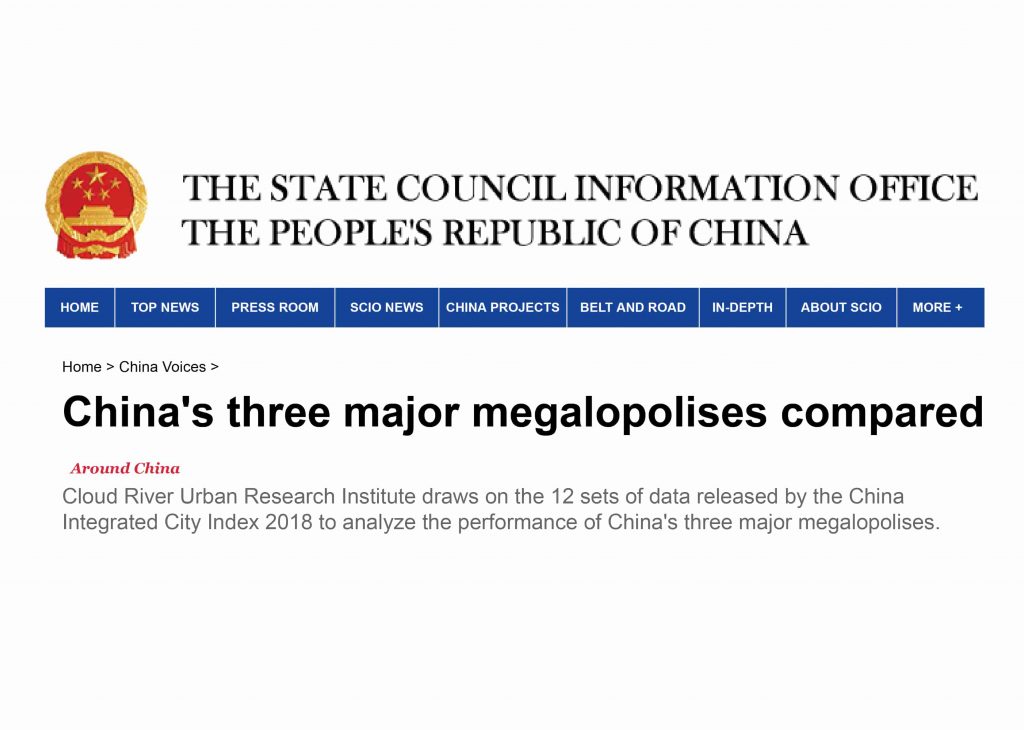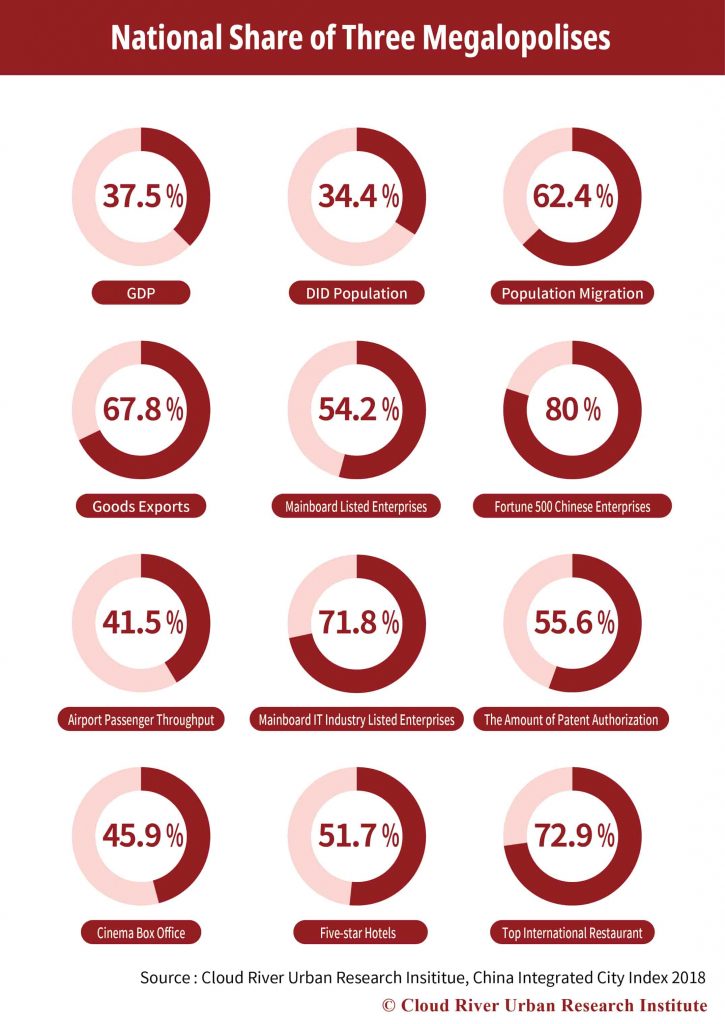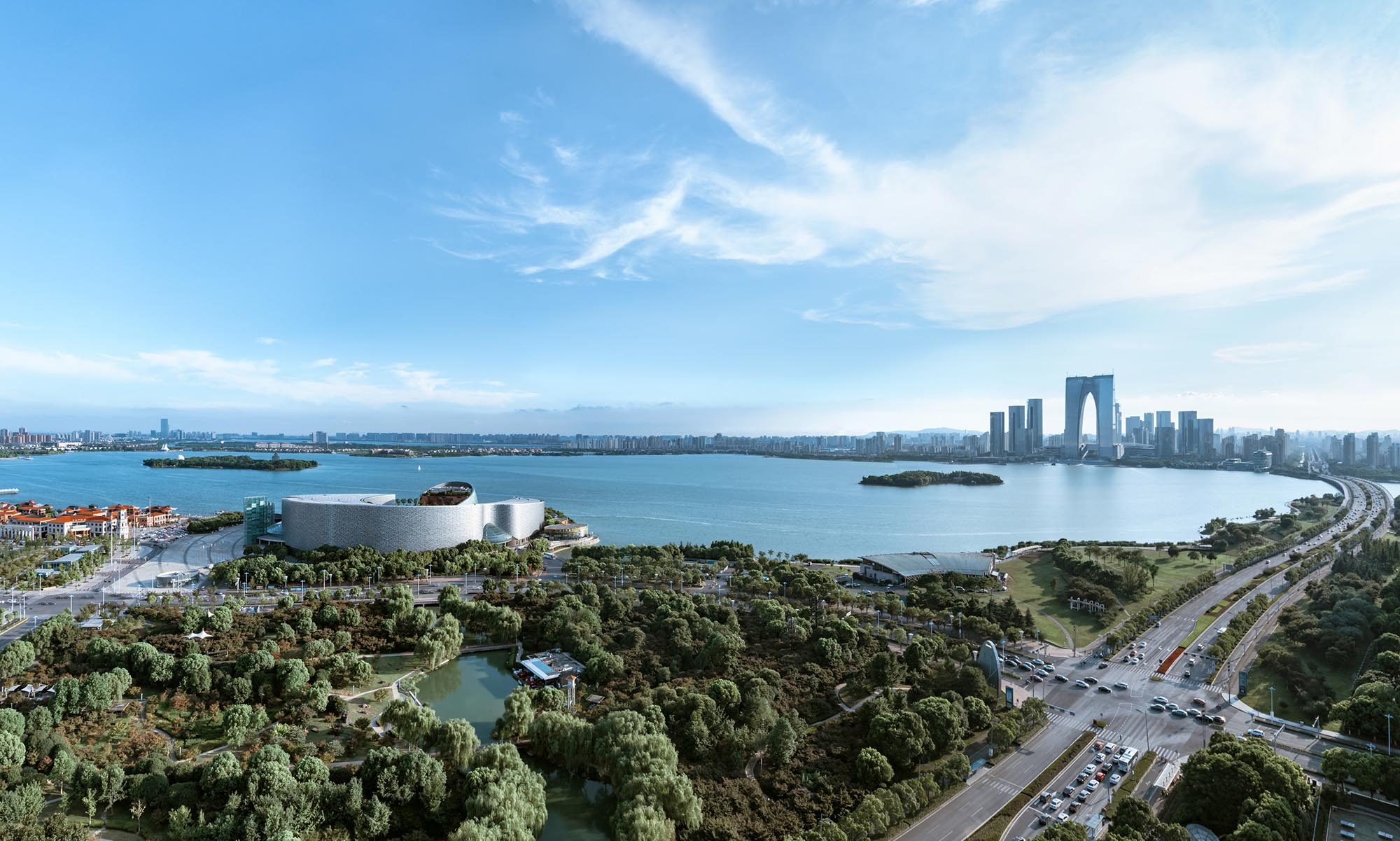
China’s rapid economic growth is the result of the combination of the world’s economic landscape shift and the huge potential unleashed by China’s reform and opening up. The Pearl River Delta, the Yangtze River Delta Megalopolis and Beijing-Tianjin-Hebei Megalopolis have become the driving force for China’s economic development, as well as China’s most international and typical megalopolises. The three megalopolises play a key role against the backdrop of the China-U.S. trade frictions and China’s economic restructure.
Cloud River Urban Research Institute, a leading think tank for city planning, draws on the 12 sets of data released by the China Integrated City Index 2018 to analyze the performance of the three megalopolises.
1. GDP
The three megalopolises carry increased weight to China’s economy, as they account for 8.6%, 19.8% and 9.0% of the national GDP, respectively, which means 37.4% combined. The three megalopolises are obviously the pillar of China’s economy.
The performance of the three major megalopolises can be measured by observing the top 30 cities among the nation’s 298 cities at prefecture level and above in terms of GDP.
The Beijing-Tianjin-Hebei Megalopolis has two cities whose GDP features in the top 30–Beijing in second place, and Tianjin in sixth.
The Pearl River Delta Megalopolis has nine cities whose GDP making the top 30, including Shanghai in first place, Suzhou in seventh, Hangzhou in 10th, Nanjing in 11th, Wuxi in 13th, Ningbo in 15h, Nantong in 19th, Hefei in 25th, Changzhou in 28th.
The Pearl River Delta Megalopolis has four cities whose GDP ranked in the top 30. They are Shenzhen in third, Guangzhou in fourth, Foshan in 17th and Dongguan in 21st.
The three megalopolises dominate the rankings with 15 in the top 30.
2. DID Population
Population density is crucial to city issues. The China City Integrated Development Index uses the index of DID (Densely Inhabited District) – districts with a population density of more than 5,000 inhabitants per square kilometer, to analyze population density.
The three megalopolises account for 34.4% of the country’s total DID population. The Beijing-Tianjin-Hebei Megalopolis accounts for 7.9% of the national DID population, the Yangtze River Delta Megalopolis 17.1%, and the Pearl River Delta Megalopolis 9.3%.
The performance of the three major megalopolises can be measured through observing the top 30 cities among the nation’s 298 cities at prefecture level and above in terms of DID population. The Beijing-Tianjin-Hebei Megalopolis has two cities ranked in the top 30–Beijing in second, and Tianjin in fifth.
The Yangtze River Delta Megalopolis has seven cities whose DID ranked in the top 30. They are Shanghai in first, Suzhou in 11th, Hangzhou 13th, Nanjing in 14th, Ningbo in 20th, Hefei in 25th, and Wuxi in 28th.
The Pearl River Delta Megalopolis has four cities whose DID population ranked in the top 30. They are Guangzhou in third, Shenzhen in fourth, Dongguan in ninth, and Foshan in 15th.
There are a total of 13 cities in the three megalopolises making the list of the top 30 cities with largest DID population. However, DID population ratios vary among the three megalopolises, with the Pearl River Delta Megalopolis at 67%, much higher than the national average of 31.9%, the Yangtze River Delta Megalopolis 46.6%, while the Beijing-Tianjin-Hebei Megalopolis only 37.8%.
3. Companies Listed on Main Boards
The three megalopolises are home to more than half of the companies listed on the main boards in Shanghai, Shenzhen and Hong Kong, with the Beijing-Tianjin-Hebei Megalopolis accounting for 15.9%, the Yangtze River Delta Megalopolis 28%, and the Pearl River Delta Megalopolis 10.3%, meaning 54.2% combined.
The three major megalopolises can be gauged by the performance of the top 30 cities among the nation’s 298 cities at prefecture level and above in terms of the number of companies listed on the main boards.
The Yangtze River Delta Megalopolis has seven cities in the top 30 cities with the most companies listed on the main boards. They are Shanghai in first place, Nanjing and Hangzhou in forth, Ningbo in ninth, Hefei in 13th, Suzhou in 21st, and Wuxi in 24th.
The Pearl River Delta Megalopolis has only two cities in the top 30, including Shenzhen in third place, Guangzhou in seventh. The megalopolis’s Dongguan and Foshan, who are well known for manufacturing, are still powered by the “factory economy.”
The three megalopolises have 11 cities making it to the list of the top 30 cities with the most companies listed on the main boards. In particular, Shanghai, Beijing and Shenzhen together are home to 31.3% of the country’s main-board-listed companies.
4. Chinese Enterprises in Fortune 500
The three megalopolises are home to 80% of the country’s Chinese enterprises entering the Fortune Global 500 list, with the Beijing-Tianjin-Hebei Megalopolis 54.3%, the Yangtze River Delta Megalopolis 14.3%, and the Pearl River Delta Megalopolis 11.4%.
The performance of the three regions can be measured by observing the top 30 cities among China’s 298 cities at prefecture level and above in terms of the number of Chinese companies on the Fortune Global 500 list.
Three cities in the Beijing-Tianjin-Hebei Megalopolis make the top 30, including Beijing coming first, and Tianjin and Shijiazhuang in 11th.
Four cities in the Yangtze River Delta Megalopolis make it into the top 30, including Shanghai in second place, Hangzhou in fourth, and Nanjing and Suzhou in seventh.
The Pearl River Delta Megalopolis has three cities in the top 30, including Shenzhen in third, Guangzhou in fourth, and Foshan in seventh.
The three regions have a total of 10 cities making the top 30. Beijing tops the list, as it has 52.4% of Fortune 500 Chinese companies.
5. Manufacturing Radiation
The three major megalopolises account for 67.8% of China’s exports in goods, with the Beijing-Tianjin-Hebei Megalopolis making up 6.2%, the Yangtze River Delta Megalopolis 32.7%, and the Pearl River Delta Megalopolis 28.8%. The three megalopolises, especially the Yangtze River Delta Megalopolis and the Pearl River Delta, serve as a powerhouse of China’s export, and are dubbed the “factory of the world.”
Radiation is the index used to measure to what extent a city’s certain function can be leveraged by others.
The China City Integrated Development Index draws on the radiation index to accurately and effectively analyze service capabilities of a city’s industries.
The performance of the three major megalopolises can be gauged through observing the top 30 cities among the nation’s 298 cities at prefecture level and above in terms of the number of Chinese companies making the Fortune Global 500 list.
Eleven cities in the Yangtze River Delta Megalopolis make it into the top 30,including Shanghai in second place, Suzhou in fourth, Ningbo in seventh, Hangzhou in ninth, Wuxi in 14th, Jiaxing in 20th, Nanjing in 21st, Jinhua in 23rd, Shaoxing in 24th, Changzhou in 26th, and Nantong in 29th.
Eight cities in the Pearl River Delta Megalopolis make it into the top 30, including Shenzhen in first place, Dongguan in third, Foshan in fifth, Guangzhou in sixth, Huizhou in 11th, Zhongshan in 13th, Zhuhai in 19th, and Jiangmen in 30th.
Twenty-one cities in the three regions make the top 30. From 2000 to 2018, China’s exports increased by tenfold to become the biggest exporter in the world. The three megalopolises have proven to be the biggest winner in the explosion of communication economy created by the global expansion of the manufacturing supplier chain.
6. IT Industry Radiation
The three megalopolises house 71.8% of China’s IT companies listed on the main boards, and 50.7% of China’s IT workers.
The Beijing-Tianjin-Hebei Megalopolis accounts for 32.5% of the national IT companies listed on the main boards, the Yangtze River Delta Megalopolis 24.8%, and the Pearl River Delta Megalopolis 14.5%.
The Beijing-Tianjin-Hebei Megalopolis accounts for 20.9% of the nation’s IT workers, the Yangtze River Delta Megalopolis 19.5%, and the Pearl River Delta Megalopolis 10.2%.
The performance of the three megalopolises can be measured by the top 30 cities among the nation’s 298 cities at prefecture level and above in terms of the IT industry radiation.
Beijing in the Beijing-Tianjin-Hebei Megalopolis takes the first spot in the top 30 cities.
Six cities in the Yangtze River Delta Megalopolis make it into the top 30, including Shanghai in second, Hangzhou in fifth, Nanjing in sixth, Suzhou in 15th, Hefei in 21st, and Wuxi in 24th.
Three cities in the Pearl River Delta Megalopolis make the top 30, including Shenzhen in third, Guangzhou in seventh, and Zhuhai in 20th.
The three megalopolises have 10 cities in the top 30. It is noteworthy that many cities with strong manufacturing radiation fail to make it into the top 30 cities with strongest IT industry radiation.
7. Higher Education Radiation
The three major megalopolises are home to 51.6% of the country’s top universities, and 28.2% of the students attending universities and colleges.
The Beijing-Tianjin-Hebei Megalopolis is home to 26.8% of the nation’s top universities, the Yangtze River Delta Megalopolis 20.9%, and the Pearl River Delta Megalopolis 3.9%.
The Beijing-Tianjin-Hebei Megalopolis has 8.3% of the nation’s students attending universities and colleges, the Yangtze River Delta Megalopolis 14.0% and the Pearl River Delta Megalopolis 5.9%.
The performance of the three megalopolises can be measured by observing the top 30 cities among China’s 298 cities at prefecture and above in terms of the radiaiton of higher education.
The Yangtze River Delta Megalopolis has five cities in the top 30, including Shanghai in second place, Nanjing in fourth, Hefei in 12th, Hangzhou in 14th, and Suzhou in 30th.
The Pearl River Delta Megalopolis only has Guangzhou in the top 30.
The three megalopolises have nine cities in the top 30. The Pearl River Delta Megalopolis has relatively weak radiaiton of higher education.
8. Science and Technology Radiation
The three megalopolises have 53.3% of the country’s R&D human resources, and 55.6% of the country’s patent licenses.
The Beijing-Tianjin-Hebei Megalopolis makes up 12.2% of the national R&D human resources, the Yangtze River Delta Megalopolis 28.5%, and the Pearl River Delta Megalopolis 12.7%.
The Beijing-Tianjin-Hebei Megalopolis makes up 10.3% of the national patent licenses, the Yangtze River Delta Megalopolis 30.9%, and the Pearl River Delta Megalopolis 14.4%.
The performance of the three megalopolises can be gauged by observing the top 30 cities among the nation’s 298 cities at prefecture level and above in terms of the radiation of science and technology.
The Beijing-Tianjin-Hebei Megalopolis has two cities making it into the top 30, including Beijing in first place, and Tianjin in eighth.
The Yangtze River Delta Megalopolis has 11 cities in the top 30, including Shanghai in second place, Hangzhou in sixth, Suzhou in ninth, Nanjing in 10th, Ningbo in 12th, Wuxi in 14th, Hefei in 17th, Shaoxing in 20th, Nantong in 21st, Jiaxing in 27th, and Changzhou in 30th.
The Pearl River Delta Megalopolis has five cities in the top 30, including Shenzhen in third place, Guangzhou in fifth, Foshan in 16th, Dongguan in 18th, and Zhongshan in 24th.
A total of 18 cities in the three megalopolises make the top 30.
9. Culture, Sports and Entertainment Radiation
The three megalopolises account for 45.9% of the national box office, and 43.3% of nation’s movie and theater attendance.
The Beijing-Tianjin-Hebei Megalopolis accounts for 9.6% of the national box office, the Yangtze River Delta Megalopolis 23.6%, and the Pearl River Delta Megalopolis 12.8%.
The Beijing-Tianjin-Hebei Megalopolis accounts for 8.5% of the national movie and theater attendance, the Yangtze River Delta Megalopolis 22.8%, and the Pearl River Delta Megalopolis 11.9%.
The performance of the three megalopolises can be gauged by observing the top 30 cities among the nation’s cities at prefecture level and above in terms of the radiation of culture, sports and entertainment.
The Beijing-Tianjin-Hebei Megalopolis has two cities in the top 30, including Beijing in first place, and Tianjin in 13th.
The Yangtze River Delta Megalopolis has 11 cities in the top 30, including Shanghai in second place, Hangzhou in seventh, Nanjing in eighth, Suzhou in 14th, Hefei in 17th, Ningbo in 25th, and Wuxi in 26th.
The Pearl River Delta Megalopolis has four cities in the top 30, including Guangzhou in fourth, Shenzhen in fifth, Dongguan in 20th, and Foshan in 23rd.
The three megalopolises have 13 cities in the top 30.
10. Catering and Hotel Radiation
The three megalopolises are home to China’s 51.7% five-star hotels and 72.9% of China’s top-notch restaurants.
The Beijing-Tianjin-Hebei Megalopolis has 11.4% of the country’s five-star hotels, the Yangtze River Delta Megalopolis 29.5%, and the Pearl River Delta Megalopolis 10.9%.
The Beijing-Tianjin-Hebei Megalopolis has 20.0% of the country’s top-notch restaurants, the Yangtze River Delta Megalopolis 37.5%, and the Pearl River Delta Megalopolis 15.4%.
The performance of the three megalopolises can be gauged by observing the top 30 cities among the nation’s cities at prefecture level and above in terms of the catering and hotel radiation.
The Beijing-Tianjin-Hebei Megalopolis has two cities in the top 30, including Beijing in second place, and Tianjin in 16th.
The Yangtze River Delta Megalopolis has eight cities in the top 30, including Shanghai in first place, Hangzhou in sixth, Suzhou in seventh, Nanjing in 11th, Ningbo in 14th, Zhoushan in 18th, Wuxi in 26th, and Hefei in 29th.
The Pearl River Delta Megalopolis has four cities in the top 30, including Guangzhou in fourth, Shenzhen in fifth, Zhuhai in 20th, and Dongguan in 27th.
A total of 14 cities in the three megalopolises make the top 30.
11. Convenience of Container Port
The three megalopolises account for 69.5% of the country’s total container throughput, with the Beijing-Tianjin-Hebei Megalopolis 8.3%, the Yangtze River Delta Megalopolis 35.2% and the Pearl River Delta Megalopolis 26%, respectively.
The performance of the three megalopolises can be gauged by observing the top 30 cities among the nation’s cities at prefecture level and above in terms of port convenience.
The Beijing-Tianjin-Hebei Megalopolis has two cities in the top 30, including Tianjin in sixth place, and Tangshan in 28th.
The Yangtze River Delta Megalopolis dominates the rankings with 11 cities in the top 30, including Shanghai in first place, Ningbo in third, Suzhou in ninth, Zhoushan in 12th, Nanjing in 15th, Nantong in 17th, Jiaxing in 20th, Wuxi in 23rd, Huzhou in 26th, Changzhou in 29th, and Shaoxing in 30th.
The Pearl River Delta Megalopolis has eight cities in the top 30, including Shenzhen in second place, Guangzhou in fourth, Dongguan in 13th, Foshan in 14th, Zhongshan in 18th, Zhuhai in 21st, Jiangmen in 25th, and Huizhou in 27th.
It turns out that the three megalopolises have 21 of the top 30 cities by container port convenience that bolster the development of the three megalopolises, especially the development of manufacturing.
12. Airport Convenience
The three megalopolises account for 41.5% of the country’s passenger throughput, and 67.8% of the country’s cargo traffic.
The Beijing-Tianjin-Hebei Megalopolis accounts for 11.9% of the country’s passenger throughput, the Yangtze River Delta Megalopolis 18.7% and the Pearl River Delta Megalopolis 10.9%.
The Beijing-Tianjin-Hebei Megalopolis accounts for 14.7% of the country’s cargo traffic, the Yangtze River Delta Megalopolis 34.6% and the Pearl River Delta Megalopolis 18.5%.
The performance of the three megalopolises can be measured by observing the top 30 cities among the nation’s 298 cities at prefecture level and above in terms of airport convenience.
The Beijing-Tianjin-Hebei Megalopolis has three cities that make it into the list of the top 30 cities with the most airport convenience–Shanghai ranked first, Hangzhou ranked eighth, and Nanjing ranked 12th.
The Pearl River Delta Megalopolis has three cities in the top 30 cities with the most airport convenience–Guangzhou ranked third, Shenzhen ranked fourth, and Zhuhai ranked 27th.
Eight cities in the three megalopoliss make it into the top 30. In particular, the international aviation hubs in Beijing, Shanghai, Guangzhou and Shenzhen make the three megalopolises the areas best served by air transport, and bolster the communication economy for megalopolises.

Cities in the three megalopolises
Ten cities in the Beijing-Tianjin-Hebei Megalopolis: Beijing, Tianjin, Shijiazhuang, Baoding, Tangshan, Qinghuangdao,
Twenty-six cities in the Yangtze River Delta: Shanghai, Nanjing, Hangzhou, Suzhou, Hefei, Wuxi, Ningbo, Changzhou, Jiaxing, Nantong, Yancheng, Yangzhou, Zhengjiang, Taizhou, Huzhou, Shaoxing, Jinhua, Zhoushan, Taizhou, Wuhu, Maanshan, Tongling, Anqing, Chuzhou, Chizhou, Xuancheng.
Nine cities in the Pearl-River Delta: Guangzhou, Shenzhen, Dongguan, Foshan, Zhuhai, Zhongshan, Jiangmen, Huizhou, Zhaoqing.
english.scio.gov.cn丨Updated: January 6, 2020
